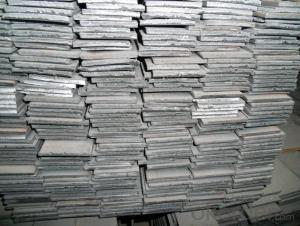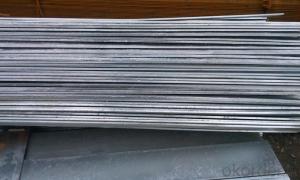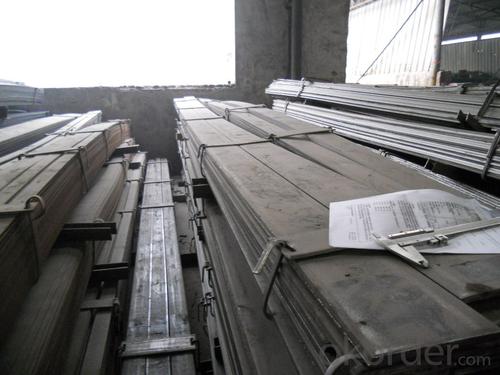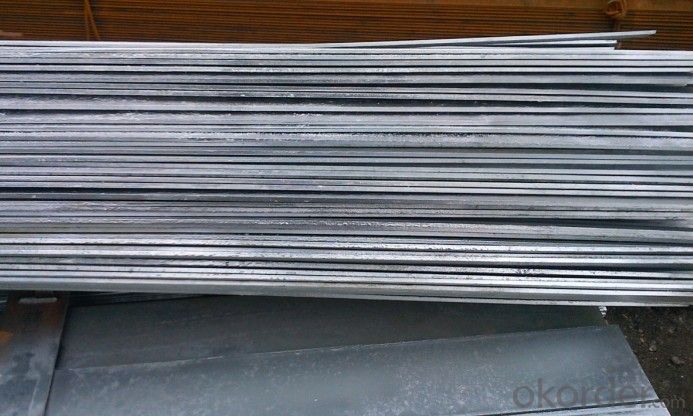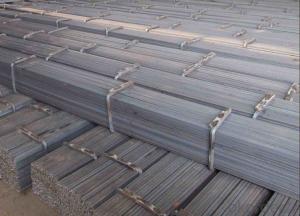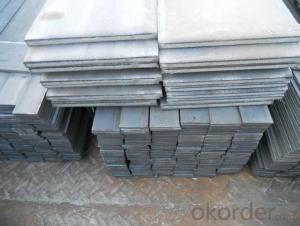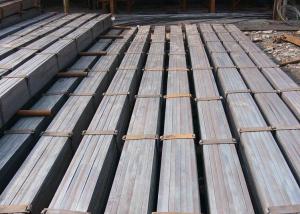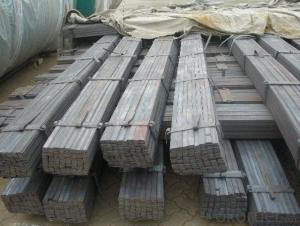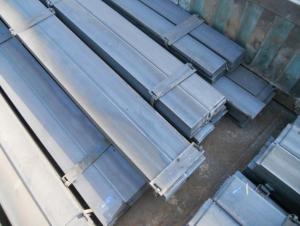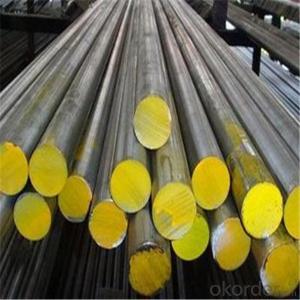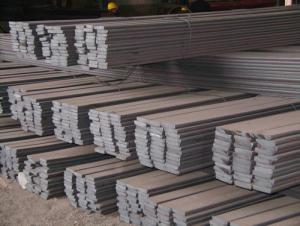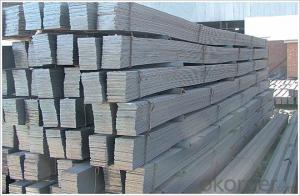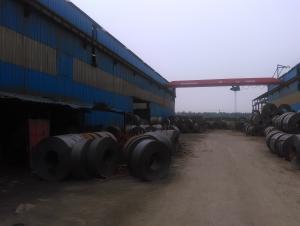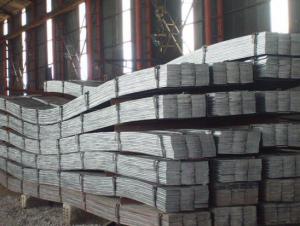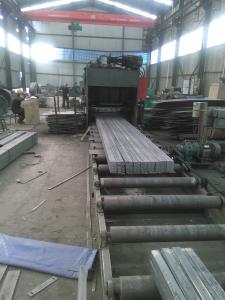flat bar
- Loading Port:
- China Main Port
- Payment Terms:
- TT OR LC
- Min Order Qty:
- -
- Supply Capability:
- -
OKorder Service Pledge
OKorder Financial Service
You Might Also Like
Product Description:
Specification of Mild Steel Flat Bar
Commodity: Mild Steel Flat Bar
Standard: GB;JIS
Material: Q195-235;SS400
Brand name: FLATSPACE
Origin place: China
Thickness: 3mm-30mm
Width:20mm-200mm
Length: Max 12m
Certification: SGS/BV
Chemical composition of Q235
Alloy No | Grade | Element(%) | ||||
C | Mn | S | P | Si | ||
Q235 | B | 0.12—0.20 | 0.3—0.7 | ≤0.045 | ≤0.045 | ≤0.3 |
Physical properties of Q235
Alloy No | Grade | Yielding strength point(Mpa) | Tensile strength (Mpa) | Elongation after fracture(%) | ||||||
Thickness (mm) | Thickness (mm) | |||||||||
≤16 | >16--40 | >40--60 | >60--100 | ≤16 | >16--40 | >40--60 | >60--100 | |||
≥ | ≥ | |||||||||
Q235 | B | 235 | 225 | 215 | 205 | 375--500 | 26 | 25 | 24 | 23 |
Usage/Applications of Mild Steel Flat Bar
Widely used for construction, Machinery manufacturing, Iron tower steel structure, Shipbuilding; Steel grating, Staircase, Bridge, Viaduct, Railway spare parts, Boilers making etc.
Packaging & Delivery of Mild Steel Flat Bar
Packaging Details: The Mild Steel Flat Bars are packed in bundles and loaded in 20 feet/40 feet container, or shipped by bulk cargo ,also we can do as customer's requirements.
Delivery Details:30~45 days upon the receipt of buyer payment by T.T. or L/C.
Production Flow of Mild Steel Flat Bar
The Mild steel flat bar is made through three processes:
1.Feeding the material: Feeding the row material (the steel plate) to Slitting Line.
2.Slitting:The steel plate would be slitted into expected width by lengthways cutter.
3. Leveled and cutting: The plat bar would be ground into level by the grinder and then cut into required length
- Q: What is the use of slitting flat steel?
- Flat cut flat steel, also called fine shearing flat steel strip, can be used to produce iron, tools and mechanical parts, and is used as frame structures and escalators for buildings.
- Q: What is the typical bend radius for steel flat bars?
- The typical bend radius for steel flat bars can vary depending on the thickness and width of the bar, as well as the specific grade of steel being used. However, as a general guideline, the minimum bend radius for steel flat bars is typically around 3 times the thickness of the bar. For example, if the flat bar is 1/4 inch thick, the minimum bend radius would be approximately 3/4 inch. It is important to note that these are just general guidelines and the specific bend radius should be determined by considering factors such as the desired bend angle, the equipment being used, and any specific requirements or standards that apply to the project.
- Q: Can steel flat bars be used for making machinery parts or components?
- Yes, steel flat bars can be used for making machinery parts or components. Steel flat bars are commonly used in machinery manufacturing due to their strength, durability, and versatility. They can be easily cut, welded, and shaped to create various machine parts such as brackets, supports, frames, and gears. Additionally, steel flat bars offer excellent structural integrity and can withstand heavy loads and high temperatures, making them ideal for machinery applications.
- Q: What are the different types of surface finishes for steel flat bars?
- There are several different types of surface finishes that can be applied to steel flat bars to enhance their appearance and functionality. Some common types of surface finishes for steel flat bars include: 1. Hot Rolled: This is the most basic surface finish for steel flat bars. It is achieved through the rolling process and leaves the surface with a rough and scale-like texture. 2. Cold Rolled: This finish is smoother and more refined than hot rolled. It is achieved by passing the steel through a series of rollers under pressure, which results in a smoother and more uniform surface. 3. Pickled and Oiled: This finish involves treating the steel with an acid solution to remove any impurities or oxides, followed by applying a thin layer of oil to protect the surface from rusting. 4. Galvanized: Galvanization is a process in which steel flat bars are coated with a layer of zinc to protect them from corrosion. This finish not only enhances the appearance but also increases the longevity of the steel. 5. Powder Coated: Powder coating is a type of surface finish that involves applying a dry powder to the steel flat bar and then curing it under heat. This results in a durable and vibrant finish that is resistant to chipping, scratching, and fading. 6. Brushed: Brushed finish involves using abrasive materials to create a pattern of fine lines on the surface of the steel flat bar. This finish gives the steel a unique and decorative appearance. 7. Polished: Polished finish involves using abrasive materials to create a smooth and reflective surface on the steel flat bar. This finish enhances the aesthetic appeal of the steel and can range from a satin finish to a mirror-like finish. These are just a few examples of the different types of surface finishes that can be applied to steel flat bars. The choice of finish will depend on the specific requirements and desired appearance of the steel.
- Q: Can steel flat bars be used for manufacturing machine guards?
- Yes, steel flat bars can be used for manufacturing machine guards. Steel is a strong and durable material, making it suitable for protecting machines and providing safety barriers. Steel flat bars can be easily cut and shaped to fit the specific requirements of the machine guard, allowing for custom designs and sizes. Additionally, steel flat bars can withstand impact and provide a sturdy barrier against potential hazards in industrial environments. Overall, steel flat bars are a commonly used material for manufacturing machine guards due to their strength, versatility, and ability to provide adequate protection.
- Q: Are steel flat bars commonly used in the construction of government buildings?
- Government buildings commonly utilize steel flat bars in their construction. Steel, being a versatile and durable material, is widely employed in the construction industry. Specifically, steel flat bars are frequently employed for structural support and reinforcement. These bars are often integrated into government buildings' columns, beams, and frames, thereby ensuring strength and stability throughout the structure. Moreover, steel flat bars are renowned for their ability to withstand fire, corrosion, and harsh weather conditions, rendering them an ideal choice for government buildings that necessitate secure and long-lasting structures.
- Q: Can steel flat bars be bent without breaking?
- Steel flat bars can indeed be bent without breaking. However, the ability of steel to withstand bending without breaking depends on several factors, including the thickness and grade of the steel, as well as the bending technique employed. Commonly, steel flat bars are bent using either cold bending or hot bending methods. Cold bending is typically employed for thin and malleable steel bars and is performed at room temperature. On the other hand, hot bending may be necessary for thicker or harder steel bars. This technique involves heating the steel to a high temperature and bending it while it is still hot. By carefully controlling the bending process and ensuring that the steel does not surpass its elastic limit, it becomes possible to bend steel flat bars without causing them to fracture.
- Q: Can steel flat bars be used for making food processing equipment?
- As long as they are made from food-grade stainless steel, steel flat bars can be utilized in the production of food processing equipment. Food-grade stainless steel is specifically engineered to ensure safety when in contact with food, as it is resistant to corrosion, staining, and the growth of bacteria. It is frequently employed in the food industry for a variety of equipment, including worktables, shelves, conveyors, and processing machines. The smooth and flat surface of steel flat bars allows for easy cleaning and maintenance, thereby upholding hygiene standards and preventing contamination. However, it is crucial to guarantee that the steel flat bars employed in food processing equipment adhere to relevant food safety regulations and standards in order to ensure the safety and quality of the processed food.
- Q: What are the different methods of surface etching for steel flat bars?
- There are several methods of surface etching for steel flat bars, each with its own advantages and applications. Here are some of the different methods commonly used: 1. Chemical Etching: This method involves using chemical solutions or acids to selectively remove the surface layer of the steel. The choice of solution and the etching time can be adjusted to achieve the desired depth and pattern. Chemical etching is versatile and can produce intricate designs, logos, or text on the surface of the flat bar. 2. Electrochemical Etching: Also known as electrolytic etching, this method utilizes an electric current to dissolve the surface layer of the steel. The flat bar is immersed in an electrolyte solution, and a stencil or mask is placed on the surface to guide the etching process. Electrochemical etching is often used for creating permanent markings, such as part numbers or identification codes, on steel flat bars. 3. Laser Etching: Laser etching is a non-contact method that uses a high-powered laser to remove the surface layer of the steel. It provides precise control over the etching process and can achieve high-resolution patterns or designs on the flat bar. Laser etching is commonly used in industries where precision and permanence are crucial, such as aerospace or medical equipment manufacturing. 4. Sandblasting: This method involves propelling abrasive particles, such as sand or grit, at high speed onto the steel flat bar's surface. The impact of the particles removes the top layer of the steel, creating a textured or roughened surface. Sandblasting is often used to improve the adhesion of coatings or paints on the flat bar, or to create a decorative or non-slip surface finish. 5. Mechanical Etching: Mechanical etching involves physically removing the surface layer of the steel using mechanical means, such as milling, grinding, or polishing. It can be used to achieve a specific surface finish or texture, such as a brushed or satin finish. Mechanical etching is often employed to enhance the aesthetic appeal of steel flat bars in architectural or interior design applications. Each of these methods offers unique benefits and can be chosen based on the specific requirements of the steel flat bar's application. It is important to consider factors such as cost, precision, speed, and the desired outcome when selecting the appropriate surface etching method.
- Q: What are the different cutting methods for steel flat bars?
- There are several cutting methods for steel flat bars, including sawing, shearing, and plasma cutting. Sawing involves using a saw blade to cut through the bar, while shearing uses a shearing machine to trim the material. Plasma cutting, on the other hand, involves using a high-temperature plasma torch to melt and separate the steel. Each method has its own advantages and is suitable for different applications and requirements.
Send your message to us
flat bar
- Loading Port:
- China Main Port
- Payment Terms:
- TT OR LC
- Min Order Qty:
- -
- Supply Capability:
- -
OKorder Service Pledge
OKorder Financial Service
Similar products
Hot products
Hot Searches
Related keywords

